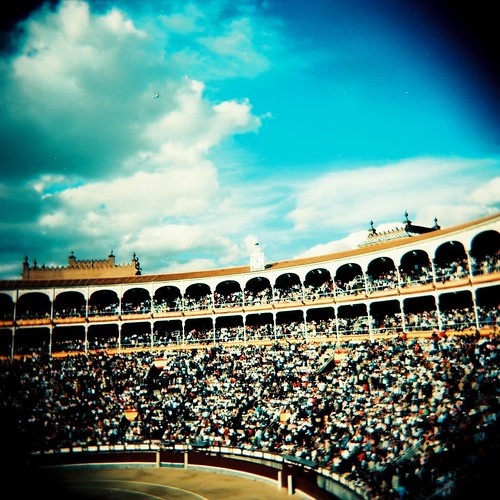San Isidro’s Feast Day

MAY 15, 2010
 |
 |
One of the most celebrated holidays of Madrid is held on May 15, the Feast Day of San Isidro who is the city’s patron saint as well as the patron saint of farmers. The traditional festival and feast are held in an open-air area known as the Pradera del Santo.
 San Isidro was born in Madrid in 1082 and died in 1172. Legend has it that while the saint was praying, two angels ploughed the land for him. Amongst the miracles attributed to him, hagiographers say that once when he was building a well, his son fell in; but through his mediation he was miraculously brought back to the parapet when the water level rose causing the child to float.
San Isidro was born in Madrid in 1082 and died in 1172. Legend has it that while the saint was praying, two angels ploughed the land for him. Amongst the miracles attributed to him, hagiographers say that once when he was building a well, his son fell in; but through his mediation he was miraculously brought back to the parapet when the water level rose causing the child to float.
Tradition also tells that San Isidro miraculously made a spring gush by banging the ground while he was ploughing. A hermitage dedicated to the saint was built on this spot in 1528, ordered by the Empress Isabel, after Prince Felipe came back into health by drinking water from the spring. Later, Baltasar de Zúñiga, Marquess of Valero, built the current day hermitage, with a single nave and a dome. In 1811 the Sacramental Cemetery San Isidro was built on the apse.
The Fiestas
On May 15, starting first thing in the morning, the La Pradera de San Isidro (the San Isidro Meadow) plays host to a thronging pilgrimage, which dates back to shortly after the death of the saint. At 12pm, the Royal Collegiate Church of San Isidro hosts the Grand Mass. After the Eucharist, the Archbishop of Madrid makes his way to the San Isidro Meadow, where he blesses the water from the spring.

In the afternoon, the image of San Isidro and his wife, Santa Maria de la Cabeza, are paraded through the streets, from Calle del Sacramento to the Plaza de la Villa, via Calle del Cordon. The peak moment for this pilgrimage was during the 19th century. In 1941, buildings started to spring up on the banks of the river Manzanares and the meadow started to shrink. But during the whole of the 19th century the celebration gathered together thousands of Madrileños and visitors every year, as depicted by key artists such as Goya.

The pilgrims would leave the city via Cuesta de la Vega and Calle de Segovia with their guitars and tambourines. On arrival at the hermitage they would attend mass and kiss the remains of the saint, contained in an 18th century shrine. They would then drink water from the spring while reciting the following words, according to the book Fiestas y tradiciones madrileñas (‘Madrid Festivals and Traditions’; published by Silex, 1990) by Pedro Montoliú: “San Isidro hermoso,/ patrón de Madrid,/ que el agua del risco / hiciste salir”. (“Beautiful Saint Isidro, Patron Saint of Madrid, you made water spring from the craggy ground”).

The tradition of drinking this water lives on to this day, alongside the tradition of the rosquillas, or ring shaped pastries known as listas (‘smart’ – bathed in sugar) and tontas (‘stupid’ – plain), pots, drinks and clay recipients.

Many families still spread their tablecloths out over the grass to picnic near the hermitage on this day. Afterwards, they can be seen at the various concerts and performances that Madrid City Council usually organises to celebrate the city’s big day.

During the San Isidro Celebrations, the other attraction is of course bullfighting. The San Isidro bullfighting festival is Spain’s most important. This is where the best bullfighters, and bulls can be seen at the Las Ventas bullring during almost a month. Tickets are sometimes hard to obtain and are best purchased in advance.

San Isidro Museum
If you wish to learn more about San Isidro you should visit the museum dedicated to this saint (Plaza de San Andrés, 2; Telephone: 91 366 74 15). Although it has changed names at different points in time, it is popularly known as the Casa de San Isidro since tradition has it that this was the house of the Vargas, gentlemen of San Isidro, and the saint lived and died here. The building was constructed in the 16th century by the Luján family.
When the Royal Court was transferred to Madrid, this was the residence of Nuncio until half way through the 17th century. Later, and until well into the 19th century, the Count and Countess of Paredes acquired the building, although it then entered a period of decline. In 1974, following an archaeological excavation, the whole complex was demolished and rebuilt.

A visit to the Museum entitles you to a visit to the Pozo del Milagro, or Miracle Well, where San Isidro supposedly saved his son by causing the water level to rise.







